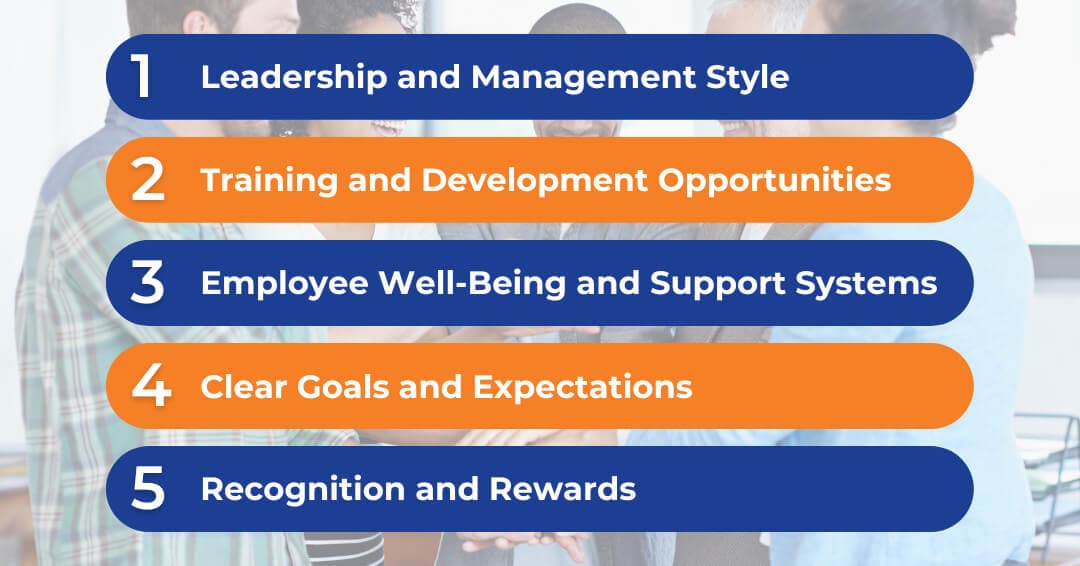
According to one recent study, about 71 percent of all executives say that employee engagement—and the performance boosts that occur as a result—are “critical” to the success of their companies.
Research has long indicated that happy, engaged employees tend to be more productive on average. That productivity translates into a 23 percent increase in profitability. Depending on the size of your business, this may mean that you could gain millions of dollars per year just by positively influencing employee performance.
Understanding the major factors that influence employee performance is essential. This insight puts you in a better position to strategically optimize them across the board, reinforcing the rock-solid foundation upon which everything else is built.

The Key Factors
1. Leadership and Management Style
One factor that can lead to poor performance is the overall leadership and management style (or lack thereof). Remember that people are being asked to devote a significant portion of their lives to helping achieve a vision, and if they don’t believe in their leader or manager, they won’t be committed to doing that—end of story.
Employees need to be fully engaged with and coached rather than just “managed.” Prioritize leadership development programs that empower leaders to support their teams better. Be sure to create a culture where employees know exactly what is expected. Only then will they be able to operate at peak performance.
2. Training and Development Opportunities
As a leader, you’ve probably prioritized the concept of continuous learning throughout your career. Indeed, it’s likely a big part of how you achieved your current status. You must take the same approach with your employees, offering them the learning and development resources needed to maintain high performance levels. You’re equipping people with the skills they need to succeed. You should also consider adopting new technologies in the workplace to help make this happen.
At Radcom, we help clients develop custom training solutions and development programs regularly.
3. Employee Performance and Support Systems
It’s important to acknowledge the significant relationship between employee support systems and overall performance. Employees who receive comprehensive support tailored to enhancing their performance often exhibit higher levels of productivity. Such support systems, by focusing on performance improvement, indirectly contribute to reduced absence and enable employees to achieve more than those without such support. By providing resources and tools aimed at performance optimization, organizations empower their staff to take charge of their productivity and efficiency.
4. Clear Goals and Expectations
Sometimes, one of the major factors influencing employee performance has less to do with communication and is more about the absence of it. Simply put, if you want someone to succeed, they need to know the marker of success. That’s why well-defined expectations are critical to enhancing performance.
Our strategy involves helping businesses of all types set clear, achievable goals that are then communicated to teams just as effectively. In the short term, this ensures everyone is always on the same page and moving in the same direction. But over time, as employees come to know exactly what is expected of them, it helps to build an environment of clarity and direction where people feel supported at all times.

5. Recognition and Rewards
Finally, it’s worth noting that recognition and rewards also significantly impact performance. If you want someone to perform up to certain expectations, look at their incentives. If you want an employee to exceed those expectations, look to the recognition and rewards you give them to incentivize precisely that.
Radcom has a long history of helping others improve performance with recognition-based models and programs. We always encourage our partners to design recognition systems that align with the company’s values and goals. This can enhance employee engagement and, ultimately, employee satisfaction.
Reflect on Your Current Practices
With all this in mind, reflecting on your current organizational practices is essential to better understanding how they align with the five key factors outlined above.
Every business is different, so there isn’t necessarily a 1:1 correlation that you’re looking for. But if employee performance is suffering, ask yourself why. Even if you believe you offer substantial training and development opportunities, are you mistakenly considering them as forms of recognition and rewards, despite them being distinct concepts? Is it a matter of failing to outline clear goals and expectations? Is it some combination of the above?
Evaluate your organization’s strengths and, most importantly, its weaknesses. Look for things to improve in relation to these five key factors. You’d be surprised by not only what a significant difference a few strategic adjustments can make but also how quickly that effort will pay off.

Implementing Changes with Radcom
At Radcom, we believe that business performance and employee improvement are closely related. Everything, from professional development opportunities to workplace culture, will somehow impact job satisfaction and business results. But more than anything, it’s essential to acknowledge that all this is unique to your business. There’s no “one size fits all” approach to increasing employee performance. Assuming there is, will only do you—and your people—a major disservice.
That’s why our relationships with our clients begin with a thorough initial consultation. We take the time to learn as much about your business, goals, and workforce as possible—so we can develop customized solutions tailored to your precise needs.
If you’d like to learn more about the five key factors influencing employee performance or want to discuss your business’s needs with an expert, contact Radcom today to schedule your free discovery session.

